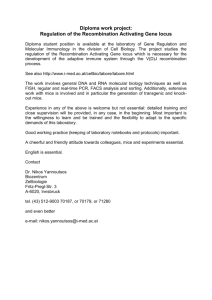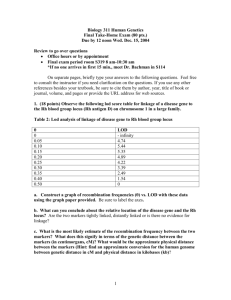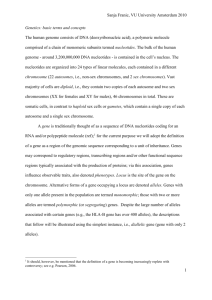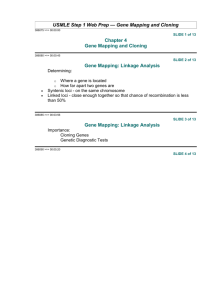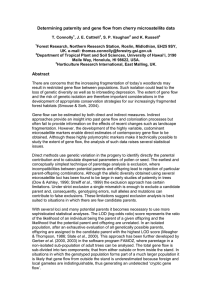Final Take-Home Exam
advertisement
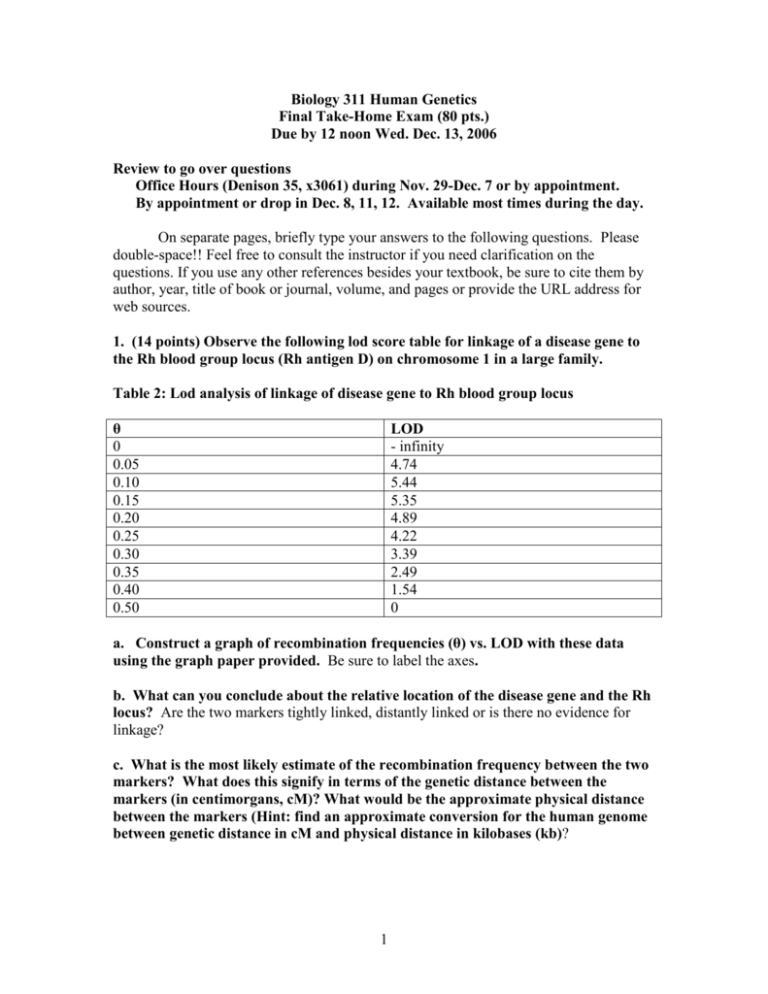
Biology 311 Human Genetics Final Take-Home Exam (80 pts.) Due by 12 noon Wed. Dec. 13, 2006 Review to go over questions Office Hours (Denison 35, x3061) during Nov. 29-Dec. 7 or by appointment. By appointment or drop in Dec. 8, 11, 12. Available most times during the day. On separate pages, briefly type your answers to the following questions. Please double-space!! Feel free to consult the instructor if you need clarification on the questions. If you use any other references besides your textbook, be sure to cite them by author, year, title of book or journal, volume, and pages or provide the URL address for web sources. 1. (14 points) Observe the following lod score table for linkage of a disease gene to the Rh blood group locus (Rh antigen D) on chromosome 1 in a large family. Table 2: Lod analysis of linkage of disease gene to Rh blood group locus θ 0 0.05 0.10 0.15 0.20 0.25 0.30 0.35 0.40 0.50 LOD - infinity 4.74 5.44 5.35 4.89 4.22 3.39 2.49 1.54 0 a. Construct a graph of recombination frequencies (θ) vs. LOD with these data using the graph paper provided. Be sure to label the axes. b. What can you conclude about the relative location of the disease gene and the Rh locus? Are the two markers tightly linked, distantly linked or is there no evidence for linkage? c. What is the most likely estimate of the recombination frequency between the two markers? What does this signify in terms of the genetic distance between the markers (in centimorgans, cM)? What would be the approximate physical distance between the markers (Hint: find an approximate conversion for the human genome between genetic distance in cM and physical distance in kilobases (kb)? 1 2. (12 points) The gene for the autosomal dominant disease shown in this pedigree is thought to be on chromosome 4, so five RFLPs (1-5) mapped on chromosome 4 were tested in all family members. The results of the testing are shown below each individual listed in the pedigree. Vertical lines represent the two homologous chromosomes and the superscripts represent different alleles of the RFLP loci. 1◦ 2◦ 3' 4◦ 5' 1◦ 2◦ 3' 4◦ 5◦ 1◦ 2' 3◦ 4' 5◦ 1' 2◦ 3◦ 4' 5◦ 1◦ 2◦ 3' 4' 5◦ 1◦ 1◦ 2" 2' 3◦ 3" 4' 4" 5◦ 5◦ 1◦ 2" 3◦ 4' 5◦ 1' 1◦ 2◦ 2' 3' 3' 4' 4' 5◦ 5◦ 1' 2◦ 3' 4◦ 5' 1◦ 2" 3◦ 4' 5◦ a. Identify the recombinant chromosomes in the individuals in generation II. Locate the approximate position where the chromosomes recombined and determine whether recombination occurred in the maternal or paternal meiosis. b. Decide which RFLP locus is closest to the disease gene (explain your logic). c. Suggest a possible strategy you could use to isolate the disease gene. Include a brief description of each of the significant methods you would use and how they would help you locate and isolate the gene. 3. (8 points) Briefly summarize in about a paragraph ONE of the class presentations other than your own. Include in your summary what the presentation was about how the presentation related to human genetics new information you learned from the presentation 2 4. (24 pts) Distinguish between any 6 of the following 12 terms or phrases. a. position-independent cloning and positional cloning b. loss of function mutations and gain of function mutations c. therapeutic cloning and reproductive cloning d. embryonic stem cells and adult stem cells e. oncogene and tumor suppressor gene f. miRNAs and siRNAs g. dicer and RISC h. sickle cell anemia and βº thalessemia i. zinc fingers and helix-turn-helix (homeodomain) j. p53 and Li-Fraumeni syndrome j. Duchenne’s muscular dystrophy and Becker’s muscular dystrophy k. Loss of heterozygosity and Knudsen’s two hit model 5. (10 points) A genetic counselor has the following DNA testing results. For each case study, describe how the test might be performed. determine what advice the counselor can offer in the way of disease risk or possible treatment for the given outcome. a. A DNA test for APOE (Apolipoprotein E) indicates the patient is homozygous for the E4 allele. b. A DNA test for Huntington's disease (HD) indicates the patient has one allele with about 50 triplet repeats and one allele with about 20 triplet repeats. 6. (12 points) A person is simultaneously heterozygous for two autosomal genetic traits. One is a recessive condition for albinism (alleles A and a); this albinism gene is found near the centromere on the long arm of an acrocentric autosome. The other trait is the dominantly inherited Huntington disease (alleles hd and HD). The Huntington gene is located near the telomere of one of the arms of a metacentric autosome. Draw all copies of the two relevant chromosomes in this person as they would appear during metaphase of (a) mitosis, (b) meiosis I and (c) meiosis II. In each figure, label the location on every chromatid of the alleles for these two genes, assuming that no recombination took place. 3

